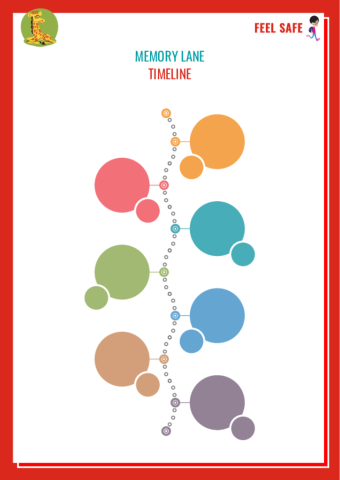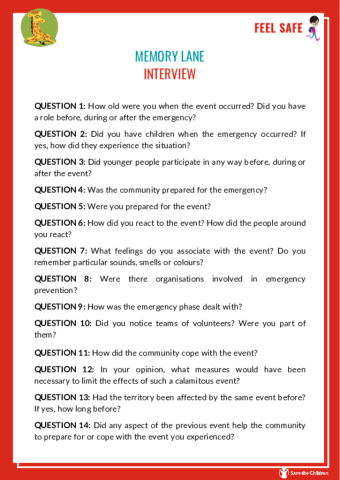Memory Lane
Objectives:
- Promot intergenerational exchange
- Learn about the adverse events that have affected one's own area
- Reflect on the involvement of young people during emergencies
STEP BY STEP
BEFORE STARTING
The teacher introduces the concept of memory using the definition in the glossary:
Memory - "strategy" of the mind to preserve traces of representations of events, people, situations or objects that belong to the past and of which we possess a direct memory or one mediated by the accounts of others.
The teacher then poses a reflective question to the class: how can memory be useful during the phases of the disaster management cycle? (To guide the discussion, it may be useful for the teacher to consult the full definition of memory and recall the definition of the disaster management cycle in the glossary).
INVESTIGATION INTO THE PAST
The teacher proposes that the class carry out an interview individually and at home with a relative or elderly person about their experience of a disaster event as a child or teenager. The interview should be carried out by choosing either to transcribe questions and answers or to make a video interview, the important thing being that each story is collected at a time and in a way that is shared by the class. The questions should be the same for everyone and should consider various aspects linked to past emergencies that can be traced back to historical events in which the people interviewed were in some way protagonists (e.g. an earthquake Sudden ground shaking resulting from movements of the earth’s crust that hit their own municipality or an event that involved a wider area but had consequences for their daily life).
The questions should concern three very specific moments:
-preparation for the event
-management during the emergency
-the post-emergency phase
The teacher may propose some stimulus questions to the class or may decide to use the attachment "Memory Line - Interview" (below).
Back in the classroom, the interviews are shared. At this stage, the teacher will take care to transcribe the name of the event and the year in which the event occurred so that the stories can be reordered chronologically.
YOUNG PEOPLE IN EMERGENCIES
Starting from the interviews conducted with the people and the elements that emerged, the teacher shifts the focus to the possible role played by young people in the reported emergencies in order to fully understand the role that young people can play during emergencies. The teacher prepares a timeline on a poster (or can use the attachment "Memory Line - Timeline" (below) and reports the chronological order of the events recounted. Each student will then fill in details about the age and the role their respondent played in the event being recounted.
The class will thus have an overview of the role young people played during past events and how this role may have changed.
CONCLUDING THOUGHTS
What happens today? Do you think young people are actively involved during emergencies? What should be their role in the different phases of the disaster management cycle?


Add new comment